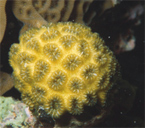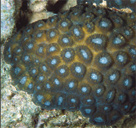| |
 |
Genetically
Unique Atlantic Coral Threatened |
downloadable
pdf
The
discovery that many Caribbean corals are only distantly related
to their counterparts in the Pacific Ocean makes the threats
of pollution and global warming even more serious, according
to a University of Florida zoologist.
Gustav Paulay, a member of the team that made the new and
surprising discovery published in the journal Nature, says
the finding means loss of the colorful underwater “gardens”
could lead to the extinction of an entire coral family.
 |
Although
these Favia coral from the Atlantic, left, and Pacific,
right, are similar looking, researchers have found they
are only distantly related, meaning pollution and global
warming could lead to the extinction of an entire coral
family. |
 |
“In the past, people have viewed the Atlantic coral
fauna as a poor version of the Pacific fauna,” said
Paulay, a UF zoologist and a contributing author of the study.
“Our findings show Atlantic corals are very distinctive
— not just superficially different — but with
a long and independent evolutionary history. If we lose them,
we’re really losing a very distinct and ancient group
of organisms.”
Overturning decades of previous scientific thought that differences
between Atlantic and Pacific coral were limited, DNA analysis
revealed that about one third of the corals in the Western
Atlantic — mostly near popular tourist spots in the
Caribbean — form a unique group only remotely related
to Pacific corals.
Compared to the richly diverse and abundant reefs of the Indian
and Pacific Oceans, which host 90 percent of the world’s
coral species, scientists have not realized the great distinctiveness
of the less diverse Atlantic corals, Paulay said.
But coral reefs in the Caribbean, which have declined by about
80 percent over the last three decades, are more vulnerable
than their Pacific and Indian Ocean counterparts largely because
greater human impact, such as overfishing and increased nutrient
runoff from sewage and fertilizer, have greatly degraded the
Caribbean reefs, Paulay said.
The biggest danger is global warming, however. A summer ocean
temperature increase of as little as a single degree Celsius
— about 2 degrees Fahrenheit — in these relatively
warm ocean waters can upset the delicate balance between reef
corals and their tiny, symbiotic algae, he said.
With the stress of high temperatures, the algae that live
within the coral suddenly leave it, causing the coral to lose
color, turn white and die if the stress is prolonged, he said.
“We hope people will recognize that the Caribbean corals
are not just poor cousins of those in the Pacific but a unique
treasure, and that they will take greater measures to protect
them,” said Paulay, who also is a curator of malacology
and invertebrate zoology at the Florida Museum of Natural
History at UF.
The research shows that if a large portion of the Caribbean
corals were to become extinct, there are no close relatives
to replace them, he said.
“The other implication is our understanding of the relationship
of coral species to each other, and the scientific system
for classifying corals will have to undergo a major overhaul,”
said Paulay. “Aside from the particular discovery of
this one significant lineage in the Atlantic, the work has
also outlined other important discrepancies between what we
thought we knew about coral relationships and what the data
reveal.”
Although typical techniques used to analyze DNA have been
applied to other organisms, they have been less successfully
applied to corals, Paulay said.
“The problem is that for some reasons that are not fully
understood, the rate of evolution in the genetic code of corals
is particularly slow,” he said. “As a result,
differences among coral species are fairly small compared
with differences among species in other organisms. This makes
resolution as to who is related to whom — the unraveling
of their genealogy or tree of life — much more difficult.”
Paulay, a coral taxonomist who has done extensive work in
the Pacific Ocean, suggested particular Pacific coral species
to use in making comparisons with Atlantic corals, and he
helped collect some samples from the Palau islands off Micronesia.
In addition to the Caribbean reefs, samples were collected
from a variety of locations worldwide, including reefs off
the coasts of Brazil, Taiwan and southern Japan.
The research was conducted by an international team of scientists
led by the Scripps Institution of Oceanography at the University
of California, San Diego and the Smithsonian Tropical Research
Institute in Panama. Paulay said the scientists isolated and
sequenced the DNA using standard techniques and compared their
genetic sequences with analytical software.
“The more (genetic) changes you see, the more distant
those corals are because the more mutations have had to accumulate
over time to set them apart,” Paulay said. “From
these events, computer programs can construct a genealogy
of these corals that basically creates a tree of life. You
can see who is related to whom and to what degree. The surprising
result was that corals from different families were more closely
related to each other than to corals thought to be from the
same family.
“The first time I heard about these results when I became
involved with this team of scientists, I was totally blown
away,” he said. “It was really counterintuitive.”
The study was led by Nancy Knowlton of the Center for Marine
Biodiversity and Conservation at the Scripps Institution of
Oceanography. Other authors included those at the University
of Iowa, Federal University of Rio de Janeiro, Institute of
Zoology at the Academia Sinica of Taiwan and the Akajima Marine
Science Laboratory of Japan.
Gustav
Paulay paulay@flmnh.ufl.edu
by
Cathy Keen
|

